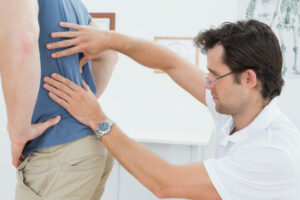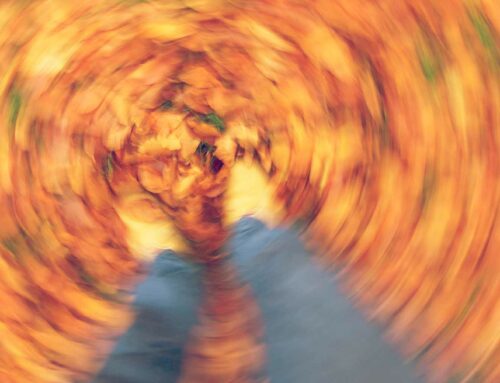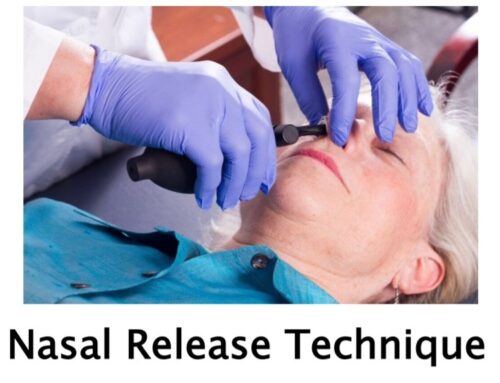Lumbar Disc Lesion
Your spine consists of 24 individual vertebrae stacked on top of each other. Flexible cushions called “discs” live between each set of vertebrae. A disc is made up of two basic components. The inner disc, called the “nucleus”, is like a ball of jelly about the size of a marble. This jelly is held in place by the outer part of the disc called the “annulus”, which is wrapped around the inner nucleus much like a ribbon wrapping around your finger. The term lumbar disc lesion means that your disc has been damaged.
Disc lesions start when the outer fibers of the disc become strained or frayed. If enough fibers become frayed, this can create a weakness and when the disc is compressed, the outer fibers may “bulge” or “protrude” like a weak spot on an inner tube. If more fibers are damaged, the nucleus of the disc may “herniate” outward. Since the spinal cord and nerve roots live directly behind the disc, bulges that are accompanied by inflammation will likely create lower back pain that radiates into the buttock or the entire lower extremity. This condition is called sciatica. If the disc bulge is significant enough to create a mechanical compression of your nerve, you may also experience loss of your reflexes and weakness. Be sure to let our office know if you notice progressive weakness or numbness, any numbness around your groin, any loss of bowel or bladder control, or fever.

Surprisingly, disc bulges are present without any symptoms in about 1/3 of the adult population. Another one-third of adults will experience pain from a lumbar disc at some point in their lifetime. The condition is more common in men. Most lumbar disc problems occur at one of the two lowest discs- L5 or L4. Smokers and people who are generally inactive have a higher risk of lumbar disc problems. Certain occupations may place you at greater risk, especially if you spend extended periods of time sitting or driving. People who are tall or overweight have an increased risk of disc problems. The condition is uncommon in children and is most common between the ages of 40 and 60.
Researchers have shown that disc bulges and sciatica may be successfully managed with conservative care like the type we will provide.
Our Treatment Here is a brief description of some of the treatments we may use to help manage your problem.
- Joint Manipulation – Your chiropractor has found joints in your body that are not moving freely. This can cause tightness and discomfort and can accelerate unwanted degeneration i.e. arthritis. Your chiropractor will apply a gentle force with their hands, or with handheld instruments, in order to restore motion to any “restricted” joints. Sometimes a specialized table will be used to assist with these safe and effective “adjustments”. Joint manipulation improves flexibility, relieves pain, and helps maintain healthy joints.
- Therapy Modalities – We may apply electrotherapy modalities that produce light electrical pulses transmitted through electrodes placed over your specific sites of concern. These comfortable modalities work to decrease your pain, limit inflammation and ease muscle spasms. Hot or cold packs are often used in conjunction, to enhance the effect of these modalities. Another available option is therapeutic ultrasound. Ultrasound pushes sound vibrations into tissues. When these vibrations reach your deep tissues, heat develops, and unwanted waste products are dispersed.
- Myofascial Release – Overworked muscles often become tight and develop knots or “trigger points”. Chronic tightness produces inflammation and swelling that ultimately leads to the formation of “adhesions” between tissues. Your chiropractor will apply pressure with their hands, or with specialized tools, in order to release muscle tightness and soft-tissue adhesions. This will help to improve your circulation, relieve pain and restore flexibility.
- Therapeutic Exercise – Muscle tightness or weakness causes discomfort and alters normal joint function, leading to additional problems. Your chiropractor will target tight or weak muscles with specific therapeutic stretching and strengthening to help increase tissue flexibility, build strength, and ease the pain. Healthy, strong, and flexible muscles may help prevent re-injury.
- Traction – Your condition is aggravated by the compression of your spinal joints and discs. We may perform traction “by hand” or utilize a specialized traction table to “decompress” these tissues. Traction helps to stretch your tight muscles and ligaments, improve nutrition to the discs and increases available space in the openings where your spinal nerves exit.
If you or someone you know suffers from low back pain, please call our office today. We have the knowledge and tools to help you feel better quickly.



